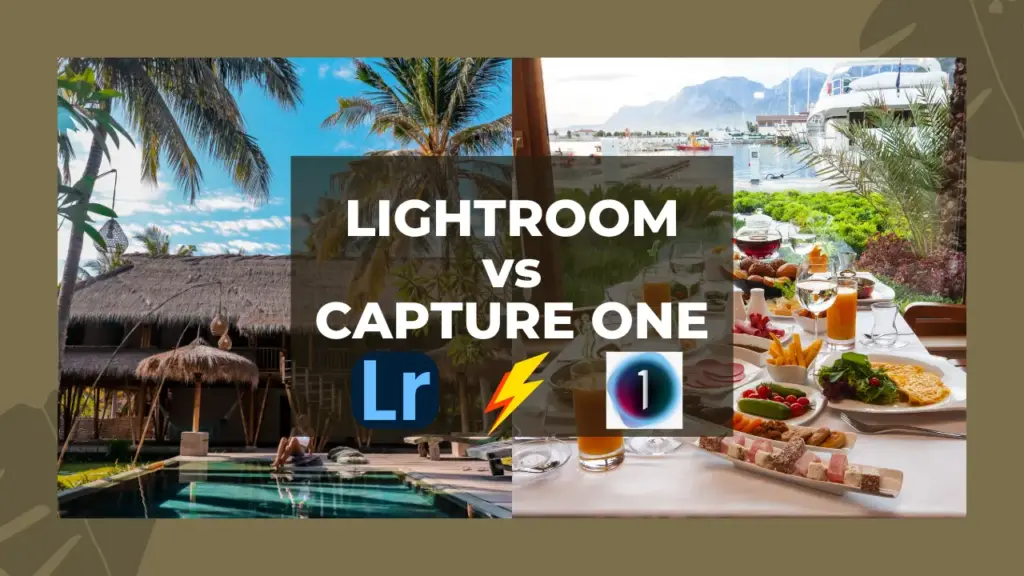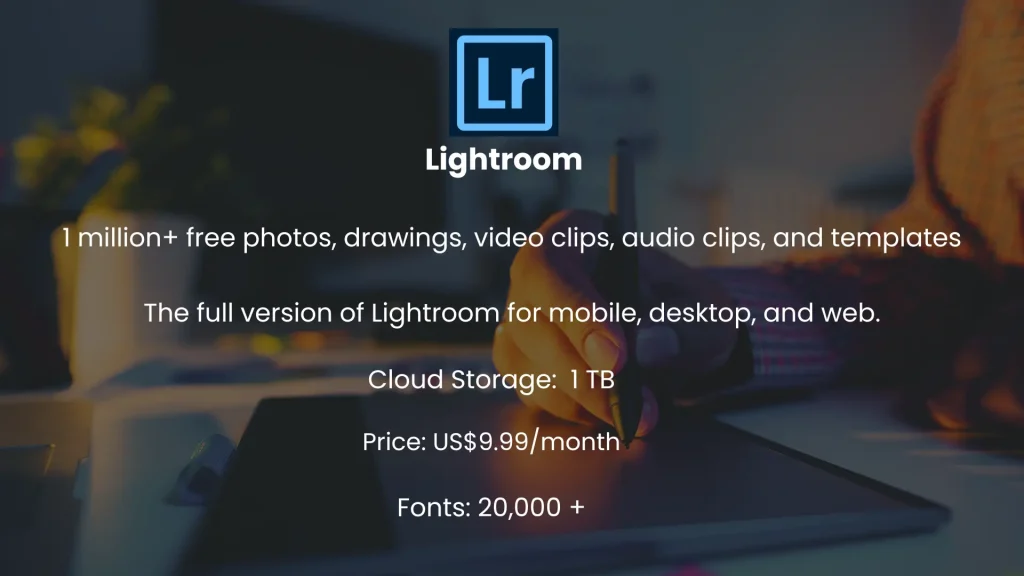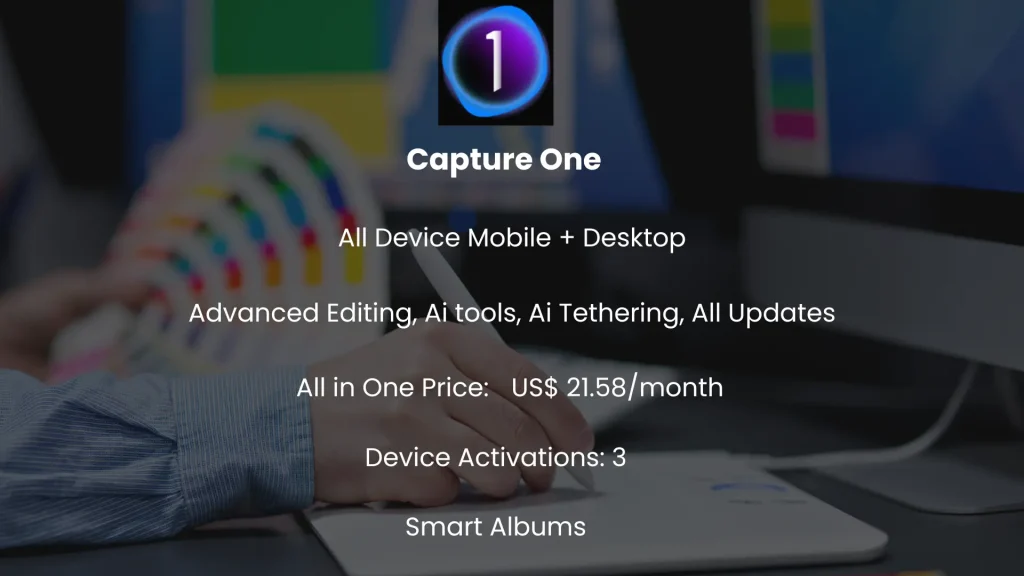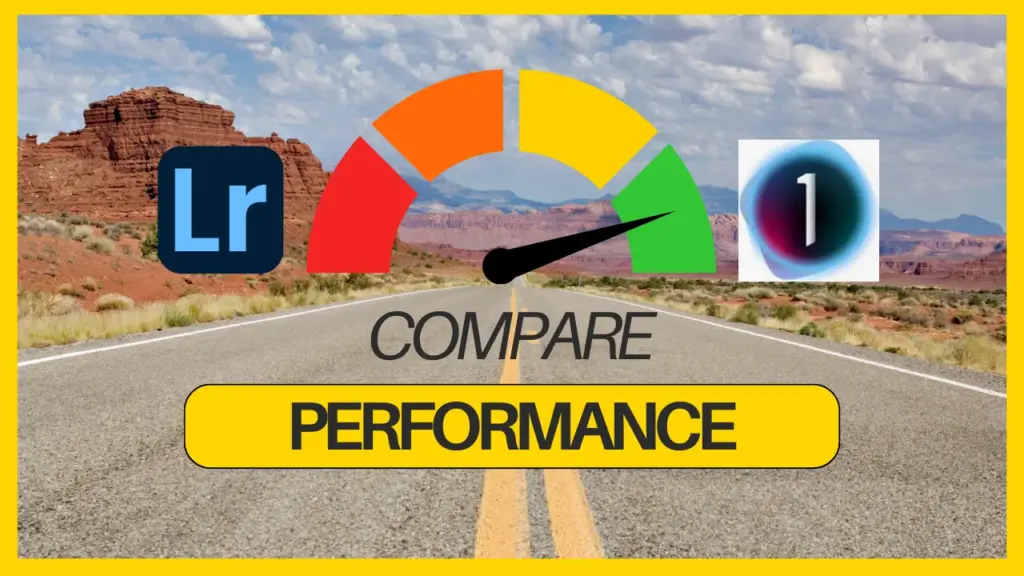In this article, I will discuss Lightroom vs Capture One in 2024. I’ll explore photo organization, user-friendliness, editing tools, cloud friendliness, pricing, performance metrics, Pros and cons, comparison chart and much more, to help you choose the right one.

Lightroom vs Capture One: License
When making the right choice between Lightroom vs Capture One, pricing and overall value are critical considerations. Both platforms offer different pricing models and packages, catering to various user needs and budgets.

Here’s a breakdown of their pricing structures and the value they provide:
Adobe Lightroom
Capture One

Lightroom vs Capture One: Comparing Value
- Target Audience: Lightroom targets a broad range of users from beginners to professionals, offering an intuitive interface and seamless integration with other Adobe products. Capture One is often the choice of professional studio photographers and those who prioritize color fidelity and detailed image editing.
- Updates and Upgrades: Both platforms offer regular updates. Lightroom’s subscription model ensures users always have access to the latest version. Capture One’s perpetual license holders may need to pay for major upgrades, although subscription users will also have continuous access to updates.
- Community and Resources: Lightroom benefits greatly, from its user community providing a range of presets, tutorials and forums for users. On the other hand, Capture One offers detailed tutorials and resources that are highly appreciated by professionals.
Ultimately the decision between Lightroom and Capture One comes down to user’s needs, budget and preferences, for specific features. It’s worth noting that you can access all features for free using the Adobe Lightroom MOD APK version. When deciding between the two options, users should consider not the costs but also the long term value provided through updates and community support.
Photo Organization: Lightroom vs Capture One
Properly managing and arranging your photos using photo editing software is important for professionals who work with a large number of images. Lightroom and Capture One each have methods for storing and organizing images. Lightroom uses Catalogs while Capture One utilizes Sessions. Knowing how these systems work can greatly impact how efficiently you work and keep your photos organized.
Adobe Lightroom: Catalogs
- Centralized System: In Lightroom there is a catalog system that acts as a database to keep track of where your photos are located and details about them. It serves as a hub for storing all your edits, metadata and organizational setups.
- Non-Destructive Editing: Changes done in Lightroom are reversible ensuring that the original files remain untouched. Instead, any changes are saved as a series of instructions within the catalog.
- Organization: Within the catalog, you have the ability to arrange photos, into collections, assign ratings, include keywords and perform tasks. This feature proves handy when handling collections of images and projects.
- Backup and Transfer: Regularly backing up your Lightroom catalog is crucial to avoid losing data. While catalogs offer capabilities they can grow in size over time. Might need effective management.
Capture One: Sessions
- Project-Based System: Capture One sessions are tailored for working on projects. Each session comprises all the files, for a project or photo shoot, such as raw files, edits and final outputs.
- Flexibility: These sessions enable photographers to manage their work in manageable portions.
- Structure: A session automatically creates a set of standard folders (Capture, Selects, Output, and Trash) to help organize your workflow from import to export. This organized structure helps in keeping track of the stages of your workflow.
- Portability: Sessions are self contained units that can be easily transferred between computers or storage devices which is especially convenient for photographers.
Lightroom vs Capture One: Photo Organization
- Workflow Consideration: Photographers who like to have all their images in one place find Lightrooms catalog system best for searching, filtering and referencing photos, across projects. On the other hand, those who prefer organizing their shoots and project by project might appreciate Capture Ones session based approach.
- Performance: As Lightroom catalogs grow, they can sometimes slow down, requiring regular maintenance and optimization. Capture One sessions, being smaller and project specific, can offer faster performance and easier management.
- Learning Curve: Both platforms come with a learning curve and users prefer one or the other depending on their workflow requirements. Beginners might find Lightrooms catalog more user friendly whereas mastering Capture One may require time and effort.
User Experience: Lightroom vs Capture One
The user interface (UI) and the overall user experience (UX) play a role, in how efficiently users can carry out their tasks in Lightroom vs Capture One. Each software provides a UI and UX each having its advantages and drawbacks. User experience can differ based on the platform. For PC users, check out our detailed guide on Lightroom for PC. Lets look at both platforms:
Adobe Lightroom
- Streamlined and Intuitive: It’s obvious user friendly and visually appealing. The organization, into sections is truly a brilliant idea! The sections (Library, Develop, Map, Book, etc.) are well defined, leading users smoothly through the steps.
- Customization: While not as customizable as Capture One, Lightroom allows some level of personalization, such as rearranging panels and setting custom presets. However, the overall structure remains relatively fixed.
- Learning Resources: Given its popularity, there’s an abundance of tutorials, online courses, and community forums available for Lightroom. This wealth of resources makes it easier for beginners to learn and master the software.
- Consistency Across Devices: Lightroom’s interface remains consistent across desktop and mobile versions, providing a seamless experience for users who work on multiple devices.
Capture One
- Highly Customizable: Capture One is well known for its interface that can be personalized to suit preferences. Users have the flexibility to adjust elements such, as tools, keyboard shortcuts and even the color scheme.
- Advanced Toolset: The interface is designed to cater to professionals who require advanced tools and precise control over their editing. This can be overwhelming for beginners.
- Focused Workflow: The organization of tools and tabs, in Capture One promotes a workflow for users. Notably the software is highly regarded for its color editing capabilities integrated seamlessly into a user interface.
- Learning Curve: Due to its complexity and customization options, Capture One generally has a steeper learning curve.
Lightroom vs Capture One: User Experience
Lightroom provides a user interface, with plenty of learning resources whereas Capture One delivers a personalized and professional experience through its customizable layout and advanced features. One noticeable change when switching from Lightroom to Capture One is the default arrangement, which usually places the tools on the side and the browser, on the side of the viewer.
If you are a beginner, I suggest you start with Lightroom instead of Capture one, because of its easy to use interface.
- Beginners vs. Professionals: Many new and intermediate users prefer Lightroom for its simple design and abundance of learning materials. On the other hand, professional photographers often opt for Capture One because of its customization options and advanced features which offer greater control.
- Speed and Efficiency: Although both programs prioritize speed and efficiency they take different approaches to achieve this goal. Lightroom’s simplicity enables users to navigate and edit quickly whereas Capture One’s flexible interface can be tailored for specific tasks.
- Community and Support: Both Lightroom and Capture One have communities and educational resources. Adobe’s extensive user community results in a range of shared presets and helpful advice. While Capture One’s smaller but dedicated community frequently offers recommendations.
Lightroom vs Capture One: Editing Tools
When comparing Lightroom vs Capture One, both are equipped with a wide array of tools and functionalities designed to cater to various editing needs. Adobe Lightroom offers a wide range of editing tools, and for those looking to explore enhanced features, the Lightroom Mod Apk provides additional capabilities that can elevate your editing experience. Here’s a comparative look at the editing tools and features of both platforms:
Adobe Lightroom
- Presets: Lightroom provides users with a range of presets that make it easy to apply effects quickly. These presets can save a lot of time. Help maintain a style across multiple photos. You can download 50+ lightroom presets here.
- Local Adjustments: Features, like the adjustment brush, graduated filter and radial filter allow users to tune parts of an image enhancing editing accuracy.
- HDR Merge and Panorama Stitching: Lightroom provides powerful tools for creating high dynamic range images and panoramas by merging multiple exposures.
- Non-Destructive Editing: All edits in Lightroom are non-destructive, meaning the original image files remain untouched. Instead, adjustments are stored separately.
- Integration with Photoshop: For more complex editing tasks, Lightroom seamlessly integrates with Adobe Photoshop, providing a comprehensive editing workflow.
Capture One
- Layers: Capture One’s layer-based editing allows for a more sophisticated adjustment process. Users can make changes, on layers adjusting how they affect the picture using opacity and masking options, giving them a lot of control over the final result.
- Color Editor and Skin Tone Tool: Capture One is renowned for its advanced color editing tools. The Color Editor provides control over color adjustments, while the Skin Tone Tool allows for precise corrections and enhancements of skin tones.
- Annotations: With the Annotations tool users can write notes. Draw directly on images, which is particularly useful when collaborating with others or marking areas for retouching.
- Tethering: Capture One offers robust tethering capabilities, allowing photographers to connect their camera directly to the software for immediate image capture and review. This feature is highly valued in studio environments and among commercial photographers.
- Styles: Similar to presets in Lightroom, Capture One’s Styles allow users to quickly apply a set of predefined adjustments. These Styles can be layered and modified, offering both convenience and customization.
Lightroom vs Capture One: Tools and Features
- User-Friendliness vs. Precision: Lightroom’s tools are generally considered more user-friendly and are excellent for quick edits and batch processing. On the other hand, Capture One’s tools are known for their precision and control catering to users, with specific and high end editing requirements.
- Customization: Capture One stands out for its customization options allowing users to tune every aspect of the editing process. While Lightroom also offers some level of customization, its layout and toolset are more standardized. Additionally, Lightroom can integrate with Photoshop, offering the capability for layer-based editing within that platform.
- Quality of Output: Both platforms deliver high quality outcomes. They take different approaches to image processing. Capture One is renowned for handling images and color grading tools whereas Lightroom excels in its reliability across editing tasks.
Lightroom is known for its user interface and vast collection of presets making it perfect for batch editing. On the other hand Capture One stands out for its color editing options, layer based adjustments and exceptional tethering capabilities. Deciding between Lightroom and Capture One depends on your editing requirements, workflow preferences, and your desired level of control and customization, in photo editing software.
Lightroom vs Capture One: Tethering Capabilities
Comparing Tethering
Capture One is well known for its tethering functions, which greatly improve the photography process, for professional photographers. Tethering establishes direct connection between the camera and the software enabling real time image capture and display.
This feature is beneficial in studio settings, where immediate feedback on images is crucial. Capture One’s tethering is known for its speed, stability, and flexibility, making it a preferred choice for many top-tier photographers. Here are six benefits of using Capture One’s tethering feature:
This function proves valuable in studio environments where immediate image feedback is essential. Capture Ones tethering feature stands out for its fast speed, reliability and adaptability making it a popular option, among photographers. Here are six advantages of utilizing Capture Ones tethering feature;
- Speed and Reliability: Capture One’s tethering is fast and reliable, ensuring a smooth and efficient workflow during shoots.
- Live View: It offers a live view feature, allowing photographers to see and adjust the scene in real-time before capturing the image.
- Advanced Camera Controls: Users have extensive control over camera settings directly from the software, including remote focus and exposure adjustments.
- Immediate Review and Adjustment: Images are instantly available for review and adjustment, enabling quick decisions on composition, lighting, and details.
- Customizable Interface: The tethering interface is highly customizable, allowing photographers to set up their workspace according to their specific needs and preferences.
- Wireless Tethering: For supported cameras, Capture One offers wireless tethering, adding flexibility and reducing the clutter of cables in the studio.
Lightroom vs Capture One: Cloud-Friendliness
Adobe Lightroom
- Cloud-Friendliness: Adobe Lightroom is well known for its cloud integration, a feature that greatly appeals to photographers those who prioritize flexibility and access across different devices.
- Cloud Storage: With Lightrooms subscription users can enjoy storage ranging from 20GB, to 1TB or more depending on the chosen plan. This feature enables users to securely store their photos and easily access them from any device at any time.
- Synchronization: Any edits made on one device are automatically synced across all devices. This seamless synchronization allows users to begin editing on their computer and seamlessly transition to their tablet or phone without interruptions.
- Lightroom Web: Users have the convenience of viewing their pictures and modifications via a web browser allowing them to operate across devices without the need for software installation.
- Sharing and Collaboration: Lightrooms cloud feature simplifies the process of sharing albums and working together with clients or team members directly via the cloud.
- Backup: By having photos and edits stored in the cloud an extra level of protection against data loss is ensured.
- Mobile Editing: The robust Lightroom mobile application provides a range of editing functions on the desktop version, all seamlessly linked to the cloud.
Capture One
- Tethering Capabilities: Capture One traditionally emphasizes editing and tethering capabilities unlike cloud features.
- No Native Cloud Storage: While it doesn’t provide its cloud storage or syncing service, users typically save files locally or on drives.
- Third-Party Integration: To enhance cloud friendliness users can link Capture One with third party cloud storage options such as Dropbox or Google Drive for syncing and backup.
- Sessions for Organization: Although not as seamless as Lightrooms integrated cloud service, Capture Ones Sessions can be stored on drives, including network attached storage (NAS) or cloud synced folders enabling some level of cloud based workflow.
- Export and Sharing: Capture One allows users to export images directly to various platforms or servers, but it lacks the integrated sharing and collaboration features found in Lightroom’s cloud ecosystem.
- Users can export images directly to platforms or servers in Capture One. But it lacks sharing and collaboration features, present in Lightrooms cloud ecosystem.
- No Mobile Application: As of the updates Capture One lacks a mobile application restricting its mobile editing capabilities compared to Lightroom.
In comparison, between Lightroom vs Capture One regarding cloud friendliness, Lightroom stands out for its integration and robust cloud features. This helps photographers who value accessibility across various devices and locations. On the other hand, Capture One leans towards storage functionality making it a preferred choice for users, who prioritize offline storage options.
Lightroom vs Capture One: Performance

Adobe Lightroom
- Speed: Lightroom is widely recognized for its import and export functions especially when handling quantities of photos. However some users may notice a decrease, in performance as their catalogs grow in size.
- Optimized Workflow: The softwares layout organized into modules simplifies the editing process by guiding users through tasks.
- Smart Previews: With Lightrooms Smart Previews feature, users can edit photos without accessing the full resolution files, which significantly speeds up editing workflows on less powerful devices.
- GPU Acceleration: Recent versions of Lightroom now come with GPU acceleration to improve performance especially when rendering images and making adjustments.
- Batch Processing: One of Lightrooms strengths lies in its ability to process batches of photos efficiently, allowing users to apply presets or edits to images at once, saving time and ensuring consistency.
Capture One
- Customizable Interface: Capture One has an interface that can be adjusted to meet individual workflow preferences potentially improving efficiency, for users who take the time to personalize their workspace.
- Layer-Based Editing: The layer based editing feature of the software not only ensures accuracy. It also enables non destructive adjustments that can be altered or undone without impacting other parts of the image, leading to a smoother editing process.
- Color Editor and Advanced Tools: Capture Ones tools, particularly its Color Editor allow for quick and precise modifications reducing the time required for color correction and grading tasks.
- Tethering: The exceptional tethering capabilities of Capture One provide an efficiency boost for studio photographers by offering due to its local storage and fast image evaluation.
- Optimized for Large Files: Capture One is optimized to handle files and high resolution images effectively, maintaining performance even when dealing with demanding file formats.
While Adobe Lightroom excels in compatibility by providing an integrated and comprehensive cloud based solution, Capture One focuses less on cloud integration and caters more towards users, who prefer local storage options.
Lightroom vs Capture One: Comparing Performance
- System Requirements: When comparing Lightroom vs capture one, both applications come with requirements that users should consider for performance. It’s important for users to make sure their hardware can handle the demands of their chosen software, especially when dealing with high resolution images or large libraries.
- Learning Curve: Mastering Capture One may be a learning challenge at first for users. But once you learned it, Its advanced customization options can significantly boost efficiency.
- Updates and Optimization: Both companies frequently release updates to enhance performance and introduce new features. It is advisable for you to stay updated to take advantage of the improvements.
In summary both Lightroom and Capture One have tools that aim to improve performance and make work processes more efficient. However they target user requirements and preferences. Lightroom focuses on simplicity and ease of use offering batch processing capabilities and seamless cloud integration. On the hand Capture One provides a platform, with advanced color editing features attracting users who prioritize top notch image quality.
Pros and Cons of Using Adobe Lightroom
Pros
- User-friendly interface that’s easy to navigate, ideal for beginners.
- Integration with Adobe Creative Cloud, allowing for seamless workflow with other Adobe applications like Photoshop.
- Extensive preset library and community resources, offering a wide range of quick editing options and learning materials.
- Cloud-based storage with Adobe’s subscription, enabling access to files and editing capabilities across multiple devices.
- Regular updates and new features added as part of the Adobe subscription model.
- Large user community, providing an abundance of tutorials, forums, and shared presets.
Cons
- Performance can slow down with large catalogs or high-resolution images.
- Limited tethering capabilities compared to Capture One, with fewer options for direct camera control.
- Subscription-based pricing model, which can be more expensive in the long run compared to a one-time purchase software.
- While it offers local adjustments, it lacks the depth of layer-based editing found in Capture one.
Pros and Cons of Using Capture One
Pros
- Highly customizable interface, allowing users to tailor the workspace to their specific needs and workflow.
- Advanced color editing tools, including the Color Editor and Skin Tone Tool, offering superior control over image hues and tones.
- Robust tethering capabilities, providing fast, stable, and feature-rich connections for studio shooting.
- Layer-based editing, enabling more sophisticated and non-destructive adjustments with greater precision.
- Sessions workflow, which is excellent for project-based organization and managing shoots individually.
- High-quality image output, particularly noted for its raw processing and detailed image rendering.
Cons
- Steeper learning curve due to its complex features and customizable interface, which might be overwhelming for beginners.
- Generally more expensive than Lightroom, especially for the perpetual license, reflecting its professional-grade tools.
- Smaller user community compared to Lightroom, which means slightly fewer resources like tutorials and third-party presets.
- Lacks the extensive cloud integration and mobile editing options provided by Lightroom, potentially limiting workflow flexibility.
- Limited integrated HDR merge and panorama stitching features, which are more robust in Lightroom.
Feature: User Interface
- Lightroom: Streamlined and intuitive
- Capture One: Highly customizable and detailed
- Lightroom vs Lightroom Classic: Understanding the differences in user interface can help users select the right tool for their editing style.
Feature: Cloud Integration
- Lightroom: Extensive with Adobe Creative Cloud
- Capture One: Limited, relies on third-party
Feature: Editing Tools
- Lightroom: Wide range, user-friendly
- Capture One: Advanced, professional-grade
Feature: Tethering
- Lightroom: Basic functionality
- Capture One: Advanced with superior performance
Feature: Color Editing
- Lightroom: Robust color correction
- Capture One: Superior color grading and control
Feature: Workflow
- Lightroom: Module-based, efficient
- Capture One: Session-based, project-focused
- Lightroom vs Lightroom Classic: Comparing workflows in Lightroom vs Lightroom Classic can help optimize efficiency for different projects.
Feature: Learning Resources
- Lightroom: Abundant tutorials and community
- Capture One: In-depth tutorials, steeper learning curve
Feature: Pricing Model
- Lightroom: Subscription-based
- Capture One: Subscription or one-time purchase
Feature: Performance with Large Files
- Lightroom: Can slow down with large catalogs
- Capture One: Optimized for high-resolution files
Feature: Mobile Editing
- Lightroom: Comprehensive mobile app
- Capture One: No dedicated mobile app
Final Thoughts
Lightroom vs Capture One both offer powerful tools and features to enhance the photography experience. Personally, I prefer Lightroom due to its easy-to-use interface and cloud-based organization. I can access my photos on the go with Lightroom mobile. I can find any tagged images easily and apply presets to my photos. However, if you are an advanced user you can use Capture One because it offers more advanced layer-based editing. You can benefit from its tethering capabilities using different cameras and lenses.
When it comes to Lightroom vs Capture One, they both provide tools and features that elevate the photography process. In my opinion I prefer Lightroom for its user interface and cloud based organization. With Lightroom mobile I can conveniently access my photos on the go. I can easily locate tagged images and apply presets to enhance my photos. On the other hand, if you’re advanced in editing, Capture One might be your go to choice, as it offers advanced layer based editing options. Additionally Capture Ones tethering capabilities with cameras and lenses can be highly beneficial for users.
I hope you have cleared all your doubts now and easily choose the best option for you based on your needs.





